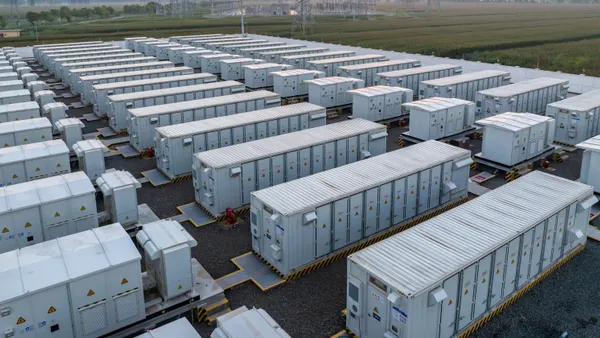Dive Brief:
- Thermal energy storage firm Malta Inc. and utility Duke Energy will partner on a study of the viability and benefits of converting retiring coal units to long-duration energy storage systems using Malta's pumped heat technology.
- Malta's pumped heat storage technology captures energy directly from a power plant or grid and stores it as heat in molten salt or as cold in a solution similar to antifreeze. That energy can then be used to power a heat engine to send electricity back to the grid.
- The year-long study, backed by the U.S. Department of Energy, will include a conceptual engineering study to see how the Malta technology could be integrated into retired coal plants in North Carolina, followed by a technology plan for a specific site. Duke Energy has six coal plants in North Carolina, one of which is set to retire three units in 2021. The study will also look at the socioeconomic benefits of the installation, including job retention, local economic impacts and environmental benefits.
Dive Insight:
The Malta system targets long-duration storage, generally defined as storage that can discharge energy upwards of 5 to 10 hours in order to power the grid during days-long periods when the sun is not shining or the wind is not blowing. The 100 MW pumped heat system can be configured to store energy for up to 200 hours, although the study with Duke Energy will focus on a 10-12 hour storage system.
"By investigating how coal units could be repurposed as long-duration storage, tech like Malta's can offer the same kind of benefits that the coal plants provided, that rotating inertia that provides stability for customers," said Ben Bollinger, vice president of strategic initiatives for Malta. "That stability can help the utility integrate more renewables because you have the foresight to say there will be supply."
Malta, a Google X spinoff, announced a $50 million series B fundraising round in February and expects to commission its first commercial scale plant in 2024 or 2025. The study with Duke Energy will probe whether it is economically and technologically feasible to bring the storage system into a coal plant and whether it offers the most cost-efficient option that Duke Energy will need as a regulated utility. Installing the technology at a retired coal plant could decrease costs by reusing existing infrastructure, but could also reduce the economic blow to communities as coal plants are scheduled to retire.
"Our plants have served as bedrocks for entire communities," said Heather Danenhower, a spokesperson for Duke Energy. "A lot of the plant neighbors and community stakeholders have a relationship with Duke Energy through their relationship with the power plants, whether that's through the workforce, the property taxes or the contributions we make in that community."
Duke has already converted several of its retiring coal plants to combined cycle natural gas plants, including the 750 MW W.S. Lee Combined Cycle Station in South Carolina and the Citrus Combined Cycle Station in Crystal River, Florida, which has two 820 MW natural gas blocks.
But meeting Duke's goal of achieving net-zero carbon emissions by 2050 will require phasing out those gas plants and boosting storage potential that can handle the intermittency of renewable energy. The utility is also participating in a $200,000 DOE-funded study with Siemens Energy and Clemson University evaluating the use of hydrogen for energy storage and as a fuel source at a power plant in South Carolina, located at the university.
Thanks to regulations and market forces that are pushing coal plants around the world into early retirement, a 2020 report from the Rocky Mountain Institute estimated that by 2025, 78% of the global coal fleet will be uncompetitive with new renewables and storage. That has led to a debate over how to best use the massive coal sites and expensive infrastructure and whether they could be folded into a grid powered by renewable energy.
In April, J-POWER USA announced plans to decommission the Birchwood Power Facility coal plant in King George, Virginia, its only coal-fired plant, and convert it into a joint facility that will produce and store solar energy. Vistra announced that as of December 2020, it had installed 300 MW/1,200 MWh of battery storage in a former turbine building at its Moss Landing Power Plant in California. Danish company Aalborg CSP A/S is also commercially offering retrofits of coal plants for thermal energy storage.
Clarification: Duke Energy notes the six coal plants in the engineering study are scheduled to retire from 2021 to 2048; only three Allen units are retiring in 2021.
CORRECTION: A previous version of the article mischaracterized the impact of the technology on retired coal plants. The retrofits would decrease the costs of a retired plant.













